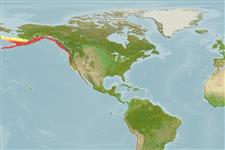Common names from other countries
Environment: milieu / climate zone / depth range / distribution range
Écologie
marin démersal; profondeur 1 - 325 m (Ref. 6793). Temperate; 64°N - 33°N, 179°W - 118°W
Eastern and Western Pacific: The Bering Sea coast of Alaska, near the Aleutian Islands (Ref. 27436) to the West Bering Sea and to Redondo Beach, southern California, USA.
Taille / Poids / Âge
Maturity: Lm ? range ? - ? cm
Max length : 63.0 cm TL mâle / non sexé; (Ref. 2850)
Description synthétique
Clés d'identification | Morphologie | Morphométrie
Épines dorsales (Total) : 0; Rayons mous dorsaux (Total) : 72 - 88; Épines anales: 0; Rayons mous anaux: 53 - 66; Vertèbres: 37 - 39. Dorsal origin above point in front of eye. Caudal rounded. Pectorals small.
Inhabits sandy bottoms. Feeds on fishes, worms, crustaceans and mollusks (Ref. 6885).
Vinnikov, K.A., R.C. Thomson and T.A. Munroe, 2018. Revised classification of the righteye flounders (Teleostei: Pleuronectidae) based on multilocus phylogeny with complete taxon sampling. Molecular phylogenetics and evolution, 125:147-162. (Ref. 122998)
Statut dans la liste rouge de l'IUCN (Ref. 130435)
CITES (Ref. 128078)
Not Evaluated
Menace pour l'homme
Harmless
Utilisations par l'homme
Pêcheries: commercial; pêche sportive: oui; Aquarium: Aquariums publics
Outils
Articles particuliers
Télécharger en XML
Sources Internet
Estimates based on models
Preferred temperature (Ref.
115969): 1.3 - 8.7, mean 5.2 (based on 314 cells).
Phylogenetic diversity index (Ref.
82804): PD
50 = 1.0000 [Uniqueness, from 0.5 = low to 2.0 = high].
Bayesian length-weight: a=0.00912 (0.00457 - 0.01819), b=3.10 (2.93 - 3.27), in cm Total Length, based on LWR estimates for this (Sub)family-body shape (Ref.
93245).
Niveau trophique (Ref.
69278): 4.1 ±0.67 se; based on food items.
Résilience (Ref.
120179): Milieu, temps minimum de doublement de population : 1,4 à 4,4 années (tm=2).
Fishing Vulnerability (Ref.
59153): Moderate to high vulnerability (45 of 100).
Climate Vulnerability (Ref.
125649): High vulnerability (62 of 100).
